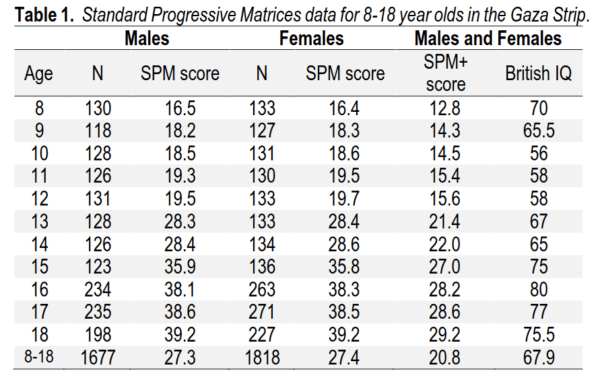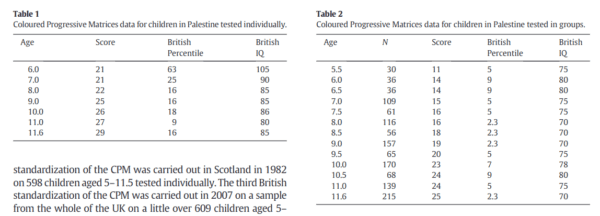Palestinians in Your Country: What to Expect?
Emil Kirkegaard, October 13, 2023
With a war looming and probably lots of Palestinian refugee applications on the horizon, I thought it would be wise to summarize what we have so far about them. The horrors of war aside, how good immigrants are the Palestinians? Denmark decided to try it out in 1992 by giving 321 rejected Palestinian asylum seekers extraordinary residence permits, granted directly by parliament by a special law (Danish Wikipedia Palæstinenserloven). These people have been followed since then to see how this experiment went. Here’s the data for the 2019 follow-up written about here:
- Of the 321 who were given asylum 270 are still residing in Denmark, meaning the rest either left or are dead.
- Of the 321, 204 (64%) have received a serious fine or jail time for crime, with 71 of them being given jail time. (Definition is fine of 1500+ DKK, traffic law excluded.)
- A very large proportion of them are receiving some kind of welfare especially the “early pension” (førtidspension) usually given to people with severe physical or mental issues (e.g. handicapped), but also used for immigrants who are basically useless on the job market for whatever reason.
- Of their 999 children, so far 34% are convicted for serious crime and some large chunk are already on welfare.
Note that some of the numbers are slightly too low because of the ones who have left.
Why so bad outcomes? Well, let’s summarize the existing intelligence studies of them.
- BAKHIET, Salaheldin Farah Attallah et LYNN, Richard. A study of the IQ in Palestine. Intelligence, 2014, vol. 47, p. 10-11.
The Coloured Progressive Matrices (CPM) was standardized in Palestine in 2011 on a sample of 257 children aged 6.0 to 11.5 years, tested individually. The sample obtained a British IQ of 85.
..
Hammad’s (2012) study also gives data for a sample of 654 boys and 604 girls aged 5.5 to 11.5 years attending representa- tive elementary schools in Gaza, of whom 1001 tested in groups as well as the 257 children tested individually. The results are given in Table 2. This shows, reading from left to right, the ages of the children, their scores on the CPM, the British Percentiles in the 2007 British standardization given in Raven (2008), and the British IQ equivalents. The mean of the IQs of the 13 age groups is 74.8. Results are also given for the mean score of boys as 21.12 (Sd = 7.38) and girls as 21.63 (Sd = 6.89). The difference is not statistically significant.
- BAKHIET, Salaheldin Farah Attallah et LYNN, Richard. Norms for the standard progressive matrices in the Gaza Strip. Mankind Quarterly, 2015, vol. 56, no 1, p. 87.
The Standard Progressive Matrices (SPM) was standardized in the Gaza Strip in 2012-13 on a sample of 1677 boys and 1818 girls aged 8 to 18 years. The sample obtained a British IQ of 67.9. The result is discussed in the context of living conditions in Gaza.

Various other proxy methods, like studying the Arabs in Israel, also produced values around 85 IQ, so somewhere around 70-85 IQ, but we don’t know exactly where. Let’s optimistically adopt the 85 value. This is about the same IQ as the African Americans. Insofar as intelligence is the chief cause of social inequality between groups, one should expect them to attain roughly equal outcomes. If we admit that radical Islam and war traumas are additional problems, performance will probably be somewhat lower than African Americans. In other words, they would be a permanent drain on the country’s resources due to high crime rates and high use of welfare, as they have already been in Denmark since 1992.
Additional government statistics
Denmark does not track ethnicity or race in government statistics. Immigrants are classified by country of origin and citizenship. So since Palestinians are not from a recognized country, they don’t get into any particular category except when they arrived from another country. Most of them have been classified as Lebanon in this way, reaching some 20k of them in Denmark. Danish Wikipedia is pretty informative about the results of using this proxy method (Google translate below):
Number and origins
In contrast to other immigrant groups in Denmark, where Statistics Denmark calculates the number of immigrants and descendants from the country in question, there is no official figure for Danes of Palestinian descent. This is because Palestine is not an official state with territory and citizenship. Palestinian immigrants are therefore registered as originating in the former country of residence where they lived before arriving in Denmark. Since the Palestinian population in the world is spread over many countries, they therefore appear with many different countries of origin in Statistics Denmark’s inventory.
However, most Danish-Palestinians living here have come here as refugees from the civil war in Lebanon and the wars in the Palestinian refugee camps in the 1980s.[1] The majority of persons with Lebanese origin in the statistics are therefore Danish-Palestinians. On 1 October 2017, there were 26,705 people of Lebanese origin in Denmark.[2] Not all of these are therefore of Palestinian origin, but conversely there are also people who are registered with e.g. Jordanian, Israeli or stateless descent who are actually of Palestinian descent. Anthropologist Anja Kublitz estimated in 2011 that there lived approx. 24,000 Palestinians in Denmark. Of these, 11-12,000 are immigrants, while the rest were born in this country and are therefore described as descendants in Statistics Denmark’s terminology.[3]
Employment
34% of the 30-64-year-old immigrants from Lebanon were employed in professional work in 2015. This is far less than the employment rate for persons of Danish origin, which was 80%, and also lower than the employment rate for immigrants from most other countries. Among the 35 largest immigrant groups, only the Somalis and the Syrians had a lower employment rate.[5]
For men the employment rate was 43% and for women 23%. Relatively many of the employed from Lebanon were self-employed, namely just over 16%, where the proportion for persons of Danish origin was only 6%.
61% of the 30-59-year-old male immigrants and 75% of the women originating in Lebanon were publicly supported, which, as mentioned, reflects the fact that most have come here as refugees. Early retirement and cash benefits were by far the most frequent transfers for these age groups.
For descendants of persons from Lebanon, employment is generally higher than for the parental generation, but lower than for persons of Danish origin. For 20-40-year-old male descendants from Lebanon, the employment rate was almost 80% of the corresponding Danish one, and for the corresponding female descendants the figure was around 65%.[5]
















